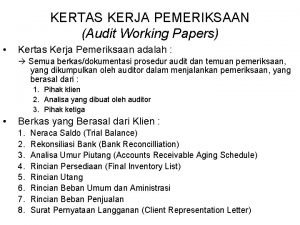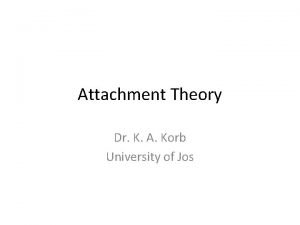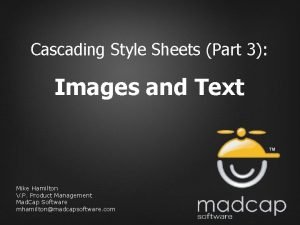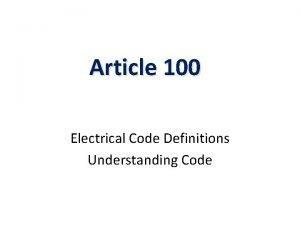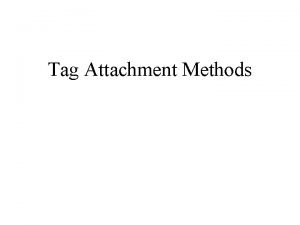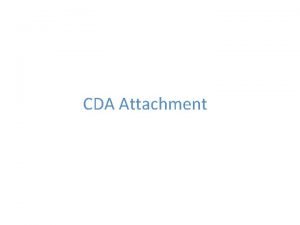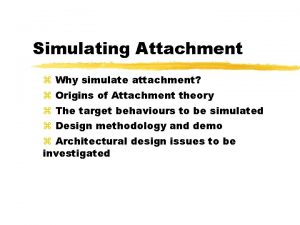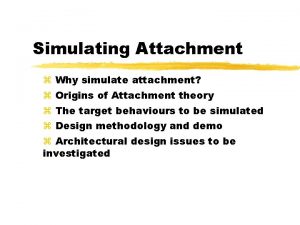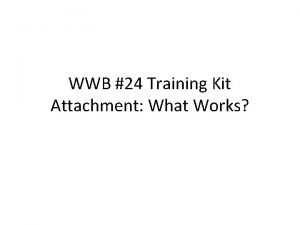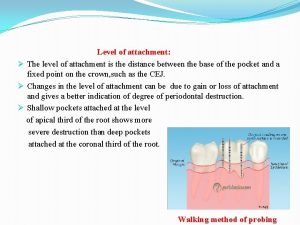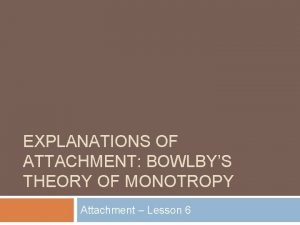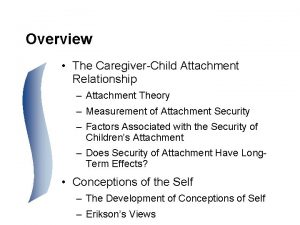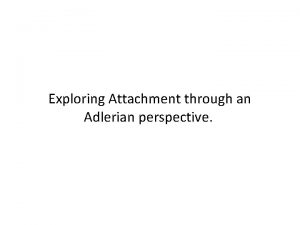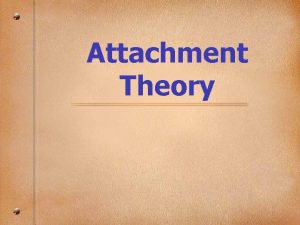Schedule A Schedule A Schedule A standard attachment























- Slides: 23

Schedule A

Schedule A � Schedule A = standard attachment that can contain all types of clauses // information � The clauses // information contained in Schedule A supersede the Agreement of Purchase and Sale

Schedule A � Pay Balance ◦ 6 Key Elements to the Pay Balance ◦ 1. 2. 3. 4. 5. 6. By whom? Amount? Adjustments? How to be paid? To whom? When to be paid? Example: Buyer agrees to pay additional $100, 000 subject to adjustments by certified cheque/bank draft to seller on completion of transaction

Schedule A ◦ Pay balance = sum of money that buyer must produce on closing day ◦ If any of the six elements or “by bank draft or certified cheque” or “subject to adjustment” are missing, pay balance is not well written ◦ We do not need to include name of the seller or the closing date in the clause ◦ Calculating pay balance �Purchase Price (PP) – Seller Take Back (STB) – Assumed Mortgage (if applicable) – deposit(s) �STB = PP – Cash (CAN) �Cash = total cash deposits + assumed mortgage + new mortgage

Schedule A � Mortgage Clauses ◦ New First Mortgage �Most lenders provide streamlined approval processes and standardized financing packages for arranging new first mortgages �These are typically written as a condition precedent (no deal until condition is waived) �Prepayment of mortgage �Not a right but a privilege under mortgage document �Pre-payment lets borrowers make additional payments or pay off mortgage before its term ends without penalty

Schedule A ◦ Assumed Mortgage �When a buyer assumes mortgage, they take over existing mortgage balance owed by the seller �They also become responsible for terms, payments and all monies owed to the mortgagee (lender) �Buyer may save appraisal fees, survey costs and select legal fees if they assume existing mortgage �Seller can save any interest differential or payout penalty that may apply (normally so if a Closed mortgage is in place) �This kind of clause is normally a true condition precedent (if lender does not approve assumption of mortgage by buyer, there is no deal)

Schedule A ◦ Seller Take Back (STB) �STB offers opportunity for creative packaging to suit the needs of the client �These are positive negotiating tools that serve both the interest of the buyer and the seller �Buyer may be able to avoid certain costs and paperwork that are normally associated with conventional lenders �Seller can improve marketability using attractive terms or achieve personal investment objectives �STBs are most effective with unique/older properties where buyers bring significant down payments to the negotiating table and sellers have enough financial reserves to assist

Schedule A � Postponement Clause ◦ If the second mortgage term is more than the first mortgage term, a postponement clause is a must ◦ For instance, a property has a first mortgage of $150, 000 for a term of 4 years and a second mortgage (STB) of $30, 000 for a term of 5 years ◦ When the first mortgage expires, the second mortgage will move to its place �This is important because the first mortgage lender will pay first in case you default ◦ If mortgage renewed after four year term, it will stay in its position and not replace the other ◦ Land Registry is based on “first-come-first-served”

Schedule A ◦ Postponement Clause insures that STB/second mortgage will always come after the first one ◦ STB mortgage cannot be assigned without obtaining consent from the lender/seller ◦ STB clauses can be identified because they start with the seller agrees to take back

Schedule A � Mortgage Condition ◦ “Approximately” is ok ◦ “Could say not more than” is still ok ◦ “Not less than” might be problematic �This could represent an Oklahoma situation whereby a property is being over-financed �In this situation, salesperson should insure that the mortgage condition (first mortgage) should include the phrase “not more than” and be written as a True Condition Precedent such that it cannot be waived �This protects sellers who offer STB, but the salesperson should also insert a clause to protect the seller from over financing that results from an Oklahoma situation

Schedule A ◦ How should the assuming mortgage clause be worded? �Bad example: “The buyer agrees to assume the first existing mortgage held by XYZ Bank for not less than” �This is wrong because it should say “not more than” for an Oklahoma situation �Assumed mortgage condition cannot be waived but near the end it says this condition can be waived by the buyer �It cannot be waived because it is up to the bank to approve – it must be fulfilled and the buyer cannot waive it �If Oklahoma: �Not less than = wrong �Condition may be waived = wrong

Schedule A �Assuming mortgage condition in Schedule A �Buyer must send seller the following document �Waiver = wrong �Termination = wrong �Fulfillment = right �Conditional upon mortgagee approval �The following sentence must always be there: “This offer is conditional upon the buyer obtaining approval of the charge/mortgage” � Sale of Buyer’s Property (SBP) ◦ This must be accompanied by an escape clause ◦ It protects both the buyer and the seller

Schedule A �Offer is conditional upon sale of buyer’s property, of which if he gives notice by a prescribed date, is fulfilled (failure to do so renders the offer null and void) – this benefits the buyer because he can waive the offer with due notice �The seller may continue to offer property for sale and receive offers from other buyers. In the event that he receives another satisfactory offer, he may notify buyer to waive condition in prescribed time �If a seller gets a better offer, he must give notice of it in no more than 48 hours

Schedule A � UFFI (Foam Insulation) ◦ If you have UFFI installed, you should insert a clause that states that the buyer acknowledges that the property contains urea formaldehyde foam insulation ◦ PHD = physical stigma of property that affects it �If UFFI is removed, this negative aspect goes away too ◦ UFFI = health hazard which must be disclosed to the other party in writing ◦ Written disclosure means you should put UFFI 1 Clause in Schedule A �You should delete pre-printed UFFI clause and add it to Schedule A if you have UFFI

Schedule A � Insurance Clause ◦ Normally written as a condition precedent (waived) �For example, a clause may say that it is the responsibility of the buyer to find insurance for the property and they must give notice to give fulfilment of this condition before a certain date, or else the offer shall be null and void. It will further state that the condition is for the benefit of the buyer and may be waived at the buyer’s sole option by giving notice to the seller

� Identification Schedule A ◦ This is a FINTRAC requirement ◦ Buyers and sellers must be verified in all transactions ◦ This can be done by checking driver’s license and filling in Form 630 which is the FINTRAC Individual Identification Record ◦ If the party is out of the country, the real estate MUST arrange to have the party meet with a contracted agent in the country they are in to verify their ID � Copies of Agreement of Purchase and Sale ◦ Registrar must make best effort to ensure that all parties to agreement receive a copy of it as soon as possible and that deposits and other related documents be delivered

Competing Offers � The registrant is required to disclose any competing offers to all persons making competing offers, but cannot disclose any details related to the substance of the offers � Substance of the offers includes deposit amount, conditions, price and closing date

Amendment � Amendments made through the parole evidence rule � If you ever want to make a change to a firm offer (contained in an Agreement of Purchase and Sale), you must draft An Amendment to the Agreement of Purchase and Sale � An Amendment can only alter purchase price, completion/closing date, Deposits, Names – only for firm offer that requires changes � Buyer and seller both must agree and sign the Amendment document to make changes to the Agreement

Commission Paid � Example: ◦ Jake is a salesperson from X Realty and is representing a client buyer. The client is interested in purchasing development land in Toronto. Jake finds a suitable property meeting the client buyer’s requirements. This property is listed by broker Jen of Y Realty Inc. with total commission of 3. 5%. The Broker/Owner Tim insists that Jake obtain a Confirmation of Co-Operation and Representation (OREA Form 320) from Y Realty Inc. MLS Listing Information says the Co-Operating Brokerage will get 1. 5% commission.

� What Commission Paid happens if salesperson Jen does not sign the form and payment to X Realty is not made? ◦ In case of an unsigned form, it might be difficult for X Realty to collect commission from Y Realty Inc. if they refuse to forward appropriate funds ◦ If the sale was an MLS transaction, regulations and by-laws of the local real estate trust board (TREB as we saw in Phase 1 also arbitrates) provide for immediate payment by the listing brokerage to the co-operating brokerage �But these only apply if the brokerages are operating within the same jurisdiction

Commission Paid ◦ It can become problematic if the listing brokerage is uncooperative and is in a different jurisdiction ◦ OREA Form 320 (The Confirmation of Co-operation and Representation) is used between boards �This is also used for exclusively listed properties

Tarion Warranty � Tarion warranties are not administered by the Ontario government, but by Tarion Warranty Corporation ◦ ◦ ◦ ◦ It is a new home warranty (not seasonal) 1 year coverage = everything 2 year coverage = Foundation Walls etc. 7 year coverage = major structural defects Septic tank coverage = up to $25, 000 New home coverage = up to $300, 000 Amenities coverage = up to $50, 000 per unit with a maximum of $2. 5 million per building

Tarion Warranty � Coverage of Resale Homes ◦ Warranty remains with a home even if ownership changes due to a resale, except if: �Temporary/seasonal – cottage not sufficiently insulated to allow year-round living, or not built on a permanent foundation �Homes built on existing foundations or footings, or otherwise converted, including: �Industrial buildings converted to residential condos �Residential apartment buildings converted to condos �Properties held by limited partnerships for purposes of investment, in which investors purchase the unit �Homes where contractor only erects shell and owner completes interior work himself
 Murid berkeperluan khas berkefungsian rendah
Murid berkeperluan khas berkefungsian rendah Rumus standar error rata-rata
Rumus standar error rata-rata What is a standard language
What is a standard language Standard costing characteristics
Standard costing characteristics Contoh working paper audit
Contoh working paper audit Reattachment and new attachment
Reattachment and new attachment The attachment theory
The attachment theory Tutor 2 u psychology
Tutor 2 u psychology Empathy theories johannes volkelt
Empathy theories johannes volkelt Spine of scapula
Spine of scapula Detachment disorders
Detachment disorders Deprivation of attachment
Deprivation of attachment Youtube.com
Youtube.com First attachment
First attachment Attachment style
Attachment style The horse ran past the barn fell
The horse ran past the barn fell Difference between precision and semi precision attachments
Difference between precision and semi precision attachments 040677 color
040677 color A feeder consists of all circuit conductors located ____.
A feeder consists of all circuit conductors located ____. Middle turbinate anatomy
Middle turbinate anatomy Bowlby's attachment theory
Bowlby's attachment theory Tag attachment
Tag attachment Action of triceps brachii muscle
Action of triceps brachii muscle Left crus of diaphragm
Left crus of diaphragm




